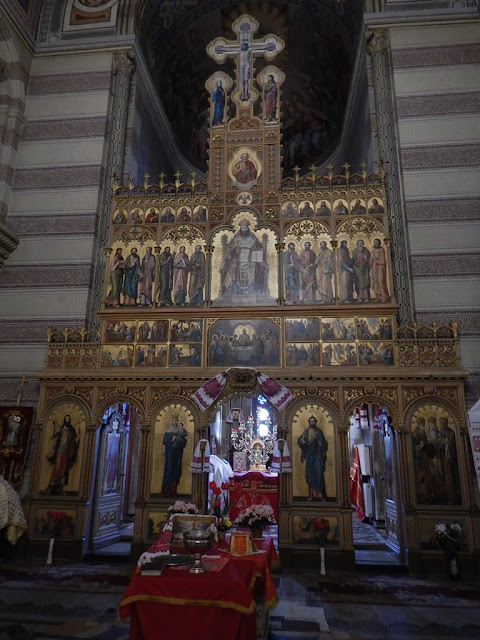In 1782, following the incorporation of Bukovina into the Habsburg Austro-Hungarian Monarchy, the seat of the Moldavian Eastern Orthodox Bishops of Rădăuți was moved to Chernivtsi (then known as Czernowitz). Unfortunately the building given to them collapsed and they were obliged to move to rented rooms. In 1851-1852, bishop Hacman sent a series of reports to the administration in Lviv, complaining that this situation was undignified. In 1860, the Religious Affairs Ministry issued a decree announcing a contest to select an architect for a new episcopal residence.
Ladies, gentlemen & horses, welcome to the residence of Bukovinian and Dalmatian Metropolitans in Chernivtsi.
The Czech architect Josef Hlávka was selected to develop the project. In preparing his designs, Hlávka researched the building traditions of the region. The resulting work combines Byzantine and Moorish style, with the Alhambra as one inspirations.
Hlávka's proposals for the complex included not only the bishop's palace but also administrative offices, meeting halls, a library, a choir school, a museum of church art and a chapel.
Construction commenced in 1864 and took over 18 years, because of substantial delays due to technical problems, the illness of Hlávka from 1872 onwards, and to disagreements between Hlávka and the local administration, which led to Hlávka's resignation.
Let's enter the residence through the main entrance.
And take the stairs to the first floor.
Through the windows we can admire the fantastic park surrounding the residence.
Let's enter the most representative room - The Synodal Hall, called also the marble hall.
Have you noticed the ceiling ?
The name of the hall comes from the many colours of marbles used to decorate the walls and columns.
And here comes the smaller representative room - the Red Hall, with all the walls covered with red Chineese silk.
Once again please raise your heads.
Let's go to the seminary church.
Here you can admire the iconostasis - a wall between the nave and the sanctuary, which is covered with icons.
What brings everyone's attentiom is the fantastic cealing, with feagures of many saints, starting with 4 evangelists.
One can also see stories from the key moments of Jesus life.
Inside an orthodox church everything looks amazing, like the manoualia with candles.
Here the visitors can see all the vessels used during celebrations.
And here comes the church in the full view.
After the World War II when the region came under Soviet control, the theological faculty was closed down; when the buildings began to be restored in 1955, they were transferred to the town's university.
It must be a great pleasure to learn in such a bautiful place.
Extensive restoration was carried out from 2004 onwards, resulting eventually in the ensemble being inscribed by UNESCO in its list of World Heritage Sites on 28 June 2011.
Next week let's smaller but also impressive tserkva, but in totally different style.
Ladies, gentlemen & horses, welcome to the residence of Bukovinian and Dalmatian Metropolitans in Chernivtsi.
The Czech architect Josef Hlávka was selected to develop the project. In preparing his designs, Hlávka researched the building traditions of the region. The resulting work combines Byzantine and Moorish style, with the Alhambra as one inspirations.
Hlávka's proposals for the complex included not only the bishop's palace but also administrative offices, meeting halls, a library, a choir school, a museum of church art and a chapel.
Construction commenced in 1864 and took over 18 years, because of substantial delays due to technical problems, the illness of Hlávka from 1872 onwards, and to disagreements between Hlávka and the local administration, which led to Hlávka's resignation.
Let's enter the residence through the main entrance.
And take the stairs to the first floor.
Through the windows we can admire the fantastic park surrounding the residence.
Let's enter the most representative room - The Synodal Hall, called also the marble hall.
Have you noticed the ceiling ?
The name of the hall comes from the many colours of marbles used to decorate the walls and columns.
And here comes the smaller representative room - the Red Hall, with all the walls covered with red Chineese silk.
Once again please raise your heads.
Let's go to the seminary church.
Here you can admire the iconostasis - a wall between the nave and the sanctuary, which is covered with icons.
What brings everyone's attentiom is the fantastic cealing, with feagures of many saints, starting with 4 evangelists.
One can also see stories from the key moments of Jesus life.
Inside an orthodox church everything looks amazing, like the manoualia with candles.
Here the visitors can see all the vessels used during celebrations.
And here comes the church in the full view.
After the World War II when the region came under Soviet control, the theological faculty was closed down; when the buildings began to be restored in 1955, they were transferred to the town's university.
It must be a great pleasure to learn in such a bautiful place.
Extensive restoration was carried out from 2004 onwards, resulting eventually in the ensemble being inscribed by UNESCO in its list of World Heritage Sites on 28 June 2011.
Next week let's smaller but also impressive tserkva, but in totally different style.






















No comments:
Post a Comment